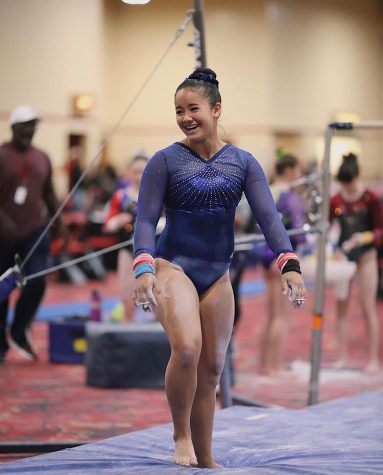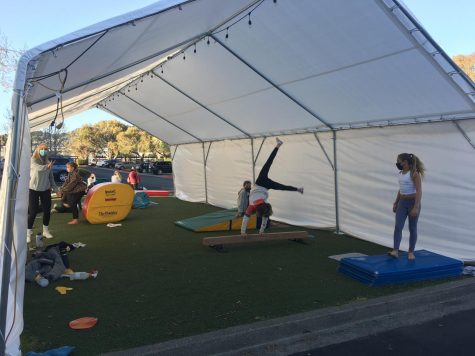“In the last 14 years, I’ve never spent that much time out of the gym, which was crazy for me. My entire life has always been in the gym,” junior Lydia Kallas said.
Kallas is a gymnast training level nine at Marin Elite Gymnastics Academy (MEGA) in San Rafael. When the pandemic began a year ago, MEGA was forced to close and training was moved online. This was especially challenging in a sport that relies on repetition and specialized equipment, such as bars and beams, which cannot be accessed outside of the gym.
“[In the beginning], there were two or three months when we were not allowed in the gym at all. We just did hour and a half-long online Zooms every day, which were a little tricky. I’d never had that much time off from the sport,” Kallas said.
Olivia Timpson, a junior and gymnastics coach who works at The Cave, a gymnastics facility in Corte Madera, led several online gymnastics classes throughout the beginning of the pandemic. She is in charge of coaching the pre-team, a group of elementary school aged gymnasts hoping to take their skills to the competitive level. She found it difficult to keep her students engaged while still working on basic skills that would keep them safe.

“I just thought it was really hard. You couldn’t see the girls all the time. A lot of times they wanted to have their cameras off, and some of them didn’t have enough space. It was really difficult to work on skills that were challenging and still [be] safe,” Timpson said.
Now, with restrictions loosening, Kallas and her team have been able to attend both outdoor practices, which are held under a large outdoor tent and only focus on the basics, like walkovers, cartwheels and back handsprings, and indoor practices, which are less frequent and have a limited capacity.
Kallas’ teammate, freshman Maya Mihara, enjoys these outdoor practices because they are a change from traditional training, but she also feels limited by the number of skills she can work on outside. Most equipment, like the bars, balance beam and vault, cannot be moved outside, so Mihara and her teammates spend limited time working on these apparatuses, making it difficult to develop and maintain new skills on these events.
“[COVID-19] has definitely been detrimental to my gymnastics [skills]. We’re training a lot less, so we can’t improve as much. I think it really set a lot of people back. I lost a lot of skills, and it was hard to come back afterwards.” Mihara said.
Even now, Kallas only practices an average of 10 hours a week, about half of what she did pre-pandemic. Despite permission to practice in the gym, Kallas and her team are still restricted by cleaning and equipment sharing procedures.
“You take a step on a beam, and you have to clean it. It gets kind of tiring after a while. We have rags, and you spray and wipe your stuff down. I haven’t physically touched anyone in the gym for almost a year now,” Kallas said. “COVID-19 makes it super difficult for my coaches to understand the standards and limitations that they need to follow, but they’ve done a really great job.”

Timpson is now able to coach in-person by utilizing large outdoor tents and bringing mats and small equipment outside. For her, the most difficult regulation to follow has been the lack of spotting. Spotting is when coaches help to lift or carry a gymnast through the skill they are working on.
“The hardest challenge was when we weren’t able to spot, because a lot of times, in order for [the students] to understand what they’re doing, you need to be able to spot them so that they’re in the right shape or so that they understand [the skill] better,” Timpson said. “I have had a lot of students that have come back, and many of them are super disappointed that they aren’t in the same place that they left off [when the gyms closed].”
Even though COVID-19 has been creating new challenges for both coaches and gymnasts, Timpson, Mihara and Kallas feel that having gyms open, even in limited capacities, has been a great outlet for gymnasts to stay connected with their friends and create a community.
“Even just having Zooms was absolutely helpful. I was going crazy without gymnastics. I don’t know what would have happened if we didn’t have some sort of connection between me and my teammates,” Kallas said.








